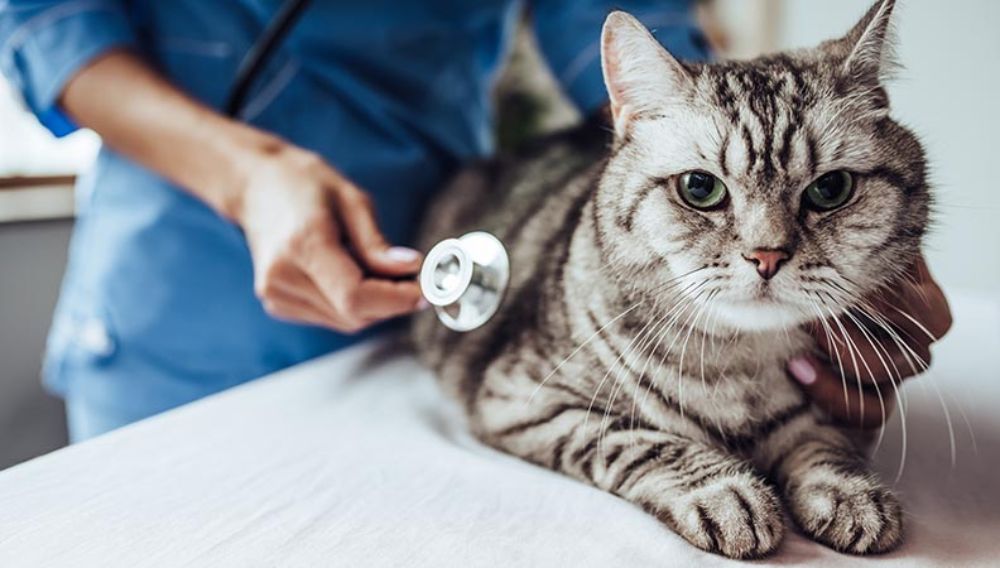
All hormones are important, and each has its own function. Thyroid hormone has an impact on many systems within the body as it controls the energy and movement within the body (metabolism). It affects the regulation of heart rate, body temperature, digestion and overall energy levels, so any disruption in thyroid hormone levels can have widespread effects on a cat's health.
How Common is Hypothyroidism in Cats?
Natural hypothyroidism in cats is extremely rare. If your cat does have natural hypothyroidism, it's likely to be present from birth, and your cat's growth will be affected.
Hypothyroidism causes include:
- Abnormally formed thyroid gland.
- Iodine deficiency.
- The thyroid gland does not respond to another hormone called thyroid stimulating hormone.
A cat's pituitary gland is located within the brain and releases a hormone called thyroid stimulating hormone (TSH). This hormone tells the thyroid to start working.
Without TSH, or if the thyroid fails to respond to TSH, thyroid hormone levels become low (hypothyroidism). Hypothyroidism can occur if the pituitary gland becomes damaged, which can happen from an injury to the head.
What Are the Causes Of Hypothyroidism in Cats?
Most cases of hypothyroidism in cats occur as a result of treatment for the opposite condition, hyperthyroidism. Hyperthyroidism is one of the most common conditions seen in cats and is where cats produce too much thyroid hormone.
Feline hypothyroidism can occur as a result of treatments designed to address the overproduction of thyroid hormone (hyperthyroidism). One of the side effects of these treatments is that the thyroid can become underactive.
Examples of treatment for hyperthyroidism in cats include oral medication, removal of the thyroid gland via surgery, iodine-restricted diet or radiation therapy.
Recognising Feline Hypothyroidism Symptoms
Thyroid problems in cats cause the following symptoms:
- Reduced growth in kittens.
- Confusion/mental dullness.
- Constipation.
- Lethargy.
- Weight gain.
- Slow heart rate and low blood pressure.
- Greasy/oily fur and skin.
- Decreased body temperature.
Hypothyroidism vs. Hyperthyroidism
It's important to note that the symptoms of hypothyroidism are the opposite of those that occur in hyperthyroidism in cats.
Therefore, when a cat is treated for hyperthyroidism, the development of these new symptoms can be missed, especially if your cat has previously experienced weight loss or hair loss.
Hyperthyroidism causes an increase a cat's metabolic rate. Due to the balance required, blood tests in both conditions are very important to check the thyroid function and ensure your cat doesn't have an overactive (HYPER) or underactive thyroid (HYPO).
How to Diagnose Thyroid Issues in Cats
If your vet suspects a thyroid problem, they'll complete a thorough clinical examination and recommend blood tests to measure your cat's thyroid hormone levels.
The blood test could be called T4. Your vet may also recommend other blood tests to check for low red blood cells (anaemia) and high blood urea nitrogen levels due to impaired kidney function (azotaemia) linked to cat hypothyroidism.
Sometimes, an ultrasound is required to evaluate the thyroid tissue and help determine the cause of hypothyroidism.
How to Treat Hypothyroidism in Cats?
The treatment for an underactive thyroid in cats varies depending on the cause.
As most cases of hypothyroidism in cats are caused by incorrect treatment levels for hyperthyroidism, the solution is often reducing their treatment or altering their treatment as recommended by your vet.
Hormone supplements/hormone replacement therapy is a common treatment for hypothyroidism. Your vet will be able to advise on the best treatment for your cat. Hormone therapy can be administered by a daily tablet or oral suspension/syrup.
Medication for Hypothyroidism in Cats
The treatment for hypothyroidism in cats is a medication called Levothyroxine. This drug may be called different names depending on the brand and licensing restrictions of the country you are in.
Other treatment options for hypothyroidism include ensuring there's enough iodine in your pet's diet, which is essential for thyroid function.
Treatment Plan for Hypothyroidism in Cats
Hypothyroidism can be a lifelong condition that requires management. It's often secondary to hyperthyroidism treatment and, therefore, can be resolved by your vet amending your cat's medications or treatment plan. It can also result from surgery, which means your cat will be started on new medications to manage this side effect.
While medication is the primary treatment, you can also help your cat by maintaining a routine, ensuring a warm home, grooming your cat regularly, handling them often, and getting them used to cat carrier.
This will help with symptoms such as confusion, feeling cold, oil build up, and stress prevention at regular vet visits. Consistent monitoring and follow-up vet visits will ensure the best outcome for your cat's thyroid health.
Everypaw Cat Insurance
Everypaw's Cat Insurance comes with 24/7 unlimited access to vets and vet nurses that can help with your pet's health, care, nutrition and behaviour. So you can rest assured your kitty cat will be well looked after.
Content provided from Vetstream's Vetlexicon Felis - www.vetlexicon.com/felis
Vetlexicon is the world’s largest peer-reviewed online clinical reference source. All our content is written and peer-reviewed by over 1,000 of the world’s leading veterinarians, ensuring relevance, accuracy and quality.
- Mardell E & Vetstream Ltd (online) Hypothyroidism. In: Vetlexicon Felis. Vetstream Ltd, UK. Website: https://www.vetlexicon.com/felis/dermatology/articles/hypothyroidism/
- Gardiner A, Harari J & Halfacree Z (online) Thyroidectomy. In: Vetlexicon Felis. Vetstream Ltd, UK. Website: https://www.vetlexicon.com/felis/surgery-soft-tissue/articles/thyroidectomy
- Nicholls P, Garrett L & Desmas-Bazelle I (online) Pituitary gland: neoplasia. In: Vetlexicon Felis. Vetstream Ltd, UK. Website: https://www.vetlexicon.com/felis/oncology/articles/pituitary-gland-neoplasia/
- Mooney C, Peterson M & Powell R (online), Thyroid: T4 assay. In: Vetlexicon Felis. Vetstream Ltd, UK. Website: https://www.vetlexicon.com/felis/internal-medicine/articles/thyroid-t4-assay/
- Graham P & Vetstream Ltd (online) Thyroid stimulating hormone (TSH). In: Vetlexicon Felis. Vetstream Ltd, UK. Website: https://www.vetlexicon.com/felis/pharmacology-therapeutics/articles/thyroid-stimulating-hormone-tsh/